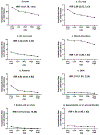Association of neighborhood opportunity and pediatric hospitalization rates in the United States
- PMID: 38073069
- PMCID: PMC10872227
- DOI: 10.1002/jhm.13252
Association of neighborhood opportunity and pediatric hospitalization rates in the United States
Abstract
We examined associations between a validated, multidimensional measure of social determinants of health and population-based hospitalization rates among children <18 years across 18 states from the 2017 Healthcare Cost and Utilization Project State Inpatient Databases and the US Census. The exposure was ZIP code-level Child Opportunity Index (COI), a composite measure of neighborhood resources and conditions that matter for children's health. The cohort included 614,823 hospitalizations among a population of 29,244,065 children (21.02 hospitalizations per 1000). Adjusted hospitalization rates decreased significantly and in a stepwise fashion as COI increased (p < .001 for each), from 26.56 per 1000 (95% confidence interval [CI] 26.41-26.71) in very low COI areas to 14.76 per 1000 (95% CI 14.66-14.87) in very high COI areas (incidence rate ratio 1.8; 95% CI 1.78-1.81). Decreasing neighborhood opportunity was associated with increasing hospitalization rates among children in 18 US states. These data underscore the importance of social context and community-engaged solutions for health systems aiming to eliminate care inequities.
© 2023 Society of Hospital Medicine.
Conflict of interest statement
Figures

Comment in
-
Moving toward equitable access to both opportunity and health.J Hosp Med. 2024 Feb;19(2):151-152. doi: 10.1002/jhm.13279. Epub 2024 Jan 19. J Hosp Med. 2024. PMID: 38243661 No abstract available.
References
-
- Noelke C, McArdle N, Baek M, et al. Childhood Opportunity Index 2.0 technical documentation. Published online 2020. Accessed February 2, 2023. chrome-extension://efaidnbmnnnibpcajpcglclefindmkaj/https://www.diversitydatakids.org/sites/default/files/2020-02/ddk_coi2.0...
Publication types
MeSH terms
Grants and funding
LinkOut - more resources
Full Text Sources

